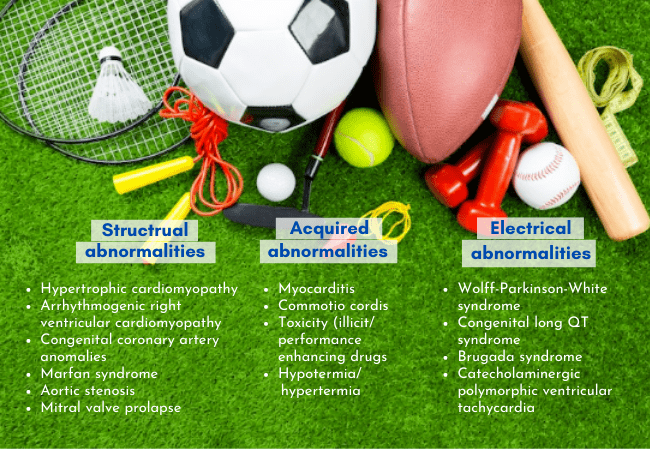By América Torres
Sudden cardiac death in athletes is a complex issue. Many sports medicine specialists from various regions of the world have worked to try to identify risk factors and quantify incidence, to try to be able to predict risk and create treatments that help reduce this phenomenon. In this article we will review some recent findings published in JACC Journals.
The challenges of studying sudden cardiac death
The challenges of studying sudden cardiac death
This event is relatively rare, so one of the challenges to obtaining reliable data is that in order to have a random variability of mortality rates, it is necessary to observe a large and stable population for many years.
A study of sudden cardiac death in athletes conducted from 2003 to 2004 in the Veneto region of Italy, showed that the incidence of SCD was 0.4 per 100,000 people per year. However, in the initial phase of this clinical trial (from 1979 to 1980) the incidence was 3.6 per 100,000 people per year, with an average of approximately 2 deaths per year, over the entire 26-year period it lasted.
Another clinical trial conducted in Israel for over 30 years showed similar results. In this case, the incidence was 2.6 per 100,000 people per year. It should be noted that over the total study period there was a peak of deaths between 1995 and 1996, with an incidence of 8.4 deaths per 100,000 people per year. In contrast, from 1989 to 1990 and from 1993 to 1994, the mortality rate was 0.
Preventive strategies
Preventive strategies
Major medical associations agree that, before competing, athletes must go through an evaluation (which varies from country to country, league and level of competition) that allows to identify, or suspect, cardiovascular abnormalities that can lead to SCD during the competition.
- The American Heart Association (AHA) has published guidelines with recommendations aimed to review 14 points related to the personal and family medical history of the athlete, in addition to going through a physical examination.
- The "Pre-Participation Physical Evaluation Monograph" ("PPE-4"), published by the American Academy of Family Physicians (AAoP), American College of Sports Medicine, American Medical Society for Sports Medicine, American Orthopaedic Society for Sports Medicine, American Osteopathic Academy of Sports Medicine and endorsed by AHA, also includes questions such as: Does anyone in your family have a heart problem, pacemaker or implanted defibrillator?, Has anyone in your family had unexplained fainting, unexplained seizures, or near drowning? , Have you ever had an unexplained seizure?
Both the AHA guidelines and the "PPE-4" monograph are considered the basis for relentless efforts to standardize such assessments in the United States.
Useful cardiac tests
Useful cardiac tests
Among the entire range of tests available, there are two that have shown their advantages to properly evaluate athletes.
Electrocardiogram. In Italy and Israel, it has become mandatory to include electrocardiograms in the "PPE-4" review of athletes. In fact, the European Society of Cardiology and the International Olympic Committee recommend including them because the data suggests that, unlike the physical examination and medical history alone, this test allows to detect cardiovascular abnormalities that can put the athlete's life at risk.
Stress test. On the other hand, although a mildly reduced ejection fraction (EF 40% to 50%) is not typical in athlete's heart, several studieshave indicated that it is associated with the dimensions of the left ventricle. These papers indicate that EF “augments normally” or becomes hyperdynamicwith exercise when observed by a stress echocardiogram. Hence the need to evaluate the advisability of practicing this test in certain cases.
Causes of sudden cardiac death in young athletes
Causes of sudden cardiac death in young athletes
The following image summarizes the main causes of this event in athletes ≤35 years old. The cardiac abnormalities that contribute to this fatal outcome fall into these 3 categories:
- Electrical abnormalities
- Acquired abnormalities
- Structural heart abnormalities
Management of the cardiopathic athlet
Management of the cardiopathic athlet
Athletes diagnosed with heart disease have special needs that require interdisciplinary medical management. But they also need to have the support of their team, league or sports association, and their loved ones´. The decision to allow them to compete, or not, is very complicated due to the wide range of factors that surround it. Therefore, it is suggested that it should be a shared decision between physicians, the athlete, his sports team or league, and of course, his family.
Conclusion
Although the efforts of researchers have allowed professional and recreational athletes to practice their respective sports relatively safer, there is still a long way to go before these patients with known, unknown, or suspected heart disease can practice them without risking their lives.
At SCHILLER we do our best to provide doctors and researchers electrocardiographs with the highest quality diagnostic EKGs and the most advanced analysis software, so that they can detect abnormalities early.
In addition, our stress test system uses industry leading algorithms that enable to assess cardiac function quickly and easily during exercise for greater diagnostic confidence
From the beginning we declared war on sudden cardiac death, that´s why we are constantly working on new developments that support researchers to continue making contributions that help to save lives.
Source: “Sudden Cardiac Death in Athletes”, Emery M, Kovacs R, et al. Sudden Cardiac Death in Athletes. J Am Coll Cardiol HF. 2018 Jan, 6 (1) 30–40.




